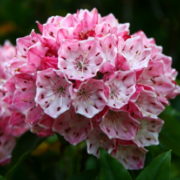THE BEAUTY OF A UNIQUE SPECIMEN – Spring at its best
The first sun begins to peep to announce the imminent arrival of spring and, with its rays, warms the soil to stimulate growth and the first blooms of specimens of all kinds.
In respect of this wonder of nature, we want to dedicate ourselves to something unique, something that we cannot always accommodate in all the gardens, but that, by its mere presence, brings color, joy, light, and stresses the new life and rebirth symbolized by growth season after the winter hibernation.
We speak, indeed, of some individual items that, by themselves, can furnish and fascinate, with their colors, their grandeur and so special features.
Let’s start from the Kalmia (Kalmia Latifolia Olympic Fire); beautiful with its lush evergreen foliage, it has a rich flowering that goes from strong pink buds up to a more tender and soft version of the open flower, from late spring.
Durable, shiny and leathery, it likes direct sunlight, but also disdains the shade, which limits only its development. Milder at a young age, it becomes solid and strong as it grows.
Thirsty, especially during flowering, it requires care and attention practically all year round, however, giving great satisfaction to those who choose it.
Usually its small size is sold, but we are able to provide such unique plants in pots that reach heights of 250-300 cm, a rarity hard to find.
Another specimen that can possibly be used as a single element in a decor is the Cornus; we have a large number of specimens, from Florida, the Florida Rubra, the Florida Rainbow, the Kousa and even a hybrid between Florida and Florida Rubra!
Certainly not easy to grow (it takes years to get to interesting dimensions), it is very attractive as it evolves during the season. Between the late winter and early spring, at the height of the bare branches, it produces small star-shaped inflorescences consisting of small yellow or green flowers. Under each inflorescence, they develop four large white bracts in the shape of heart that, for some hybrids and varieties, can be pink or red.
Let’s discuss about the time of flowering, unfortunately quite short, but with wonderful and elegant inflorescences that are worth the months of waiting with the plant completely bare.
After flowering, the handsome foliage develops, and the small red fruits ripen in September, also gathered in small groups, at the height of the branches.
Lover of bright and humid climate positions, it fears the drought and too much heat.
We are happy to offer you wonderful specimens stunning characterized large size, up to 400 cm!
Let’s talk about the Hamamelis (we have specimens of Hamamelis Mollis and Hamamelis Mollis Westerstede), the one flowing when the branches are still bare, even in cold weather.
Its name indicates its particularity, Hamamelis means “together with fruit”, because this plant produces flowers when they are still present and ripe fruits of the previous year. There are many varieties that boast subtle flowers characterized by wrinkled petals of various colors, from yellow to orange lemon, pink or purple.
Strong, vigorous and rustic, it is a plant that does not disappoint, especially when placed in a bright position and when you take care of it.
Ready for coloring gardens and flower beds, also for this variety we are able to provide rare specimens that reach 400 cm in height.
We end this series with an absolute novelty, the Oxydendron Arboreum, a very particular plant native to North America, as indeed all the other varieties of this item.
Characterized by serrated leaves of rich green, in the autumn season they turn to bright red before losing them. Characterized by small white bell-shaped flowers united in groups, it has a trunk of a nice brown color.
Usually used as an ornamental tree in parks and gardens, it is well loved for its rich flowering and for the beautiful colors of the leaves in all seasons.
Also used by Indian tribes for the construction of the arches with which shooting their arrows, it has many uses in herbal medicine and in the cuisine.
Come and see with your eyes the beauty of these specimens and tantalize your customers, landscapers or private beings, to accommodate specimens of such beauty in their garden.



